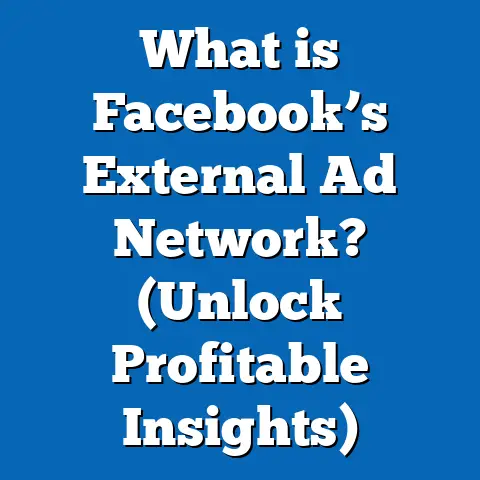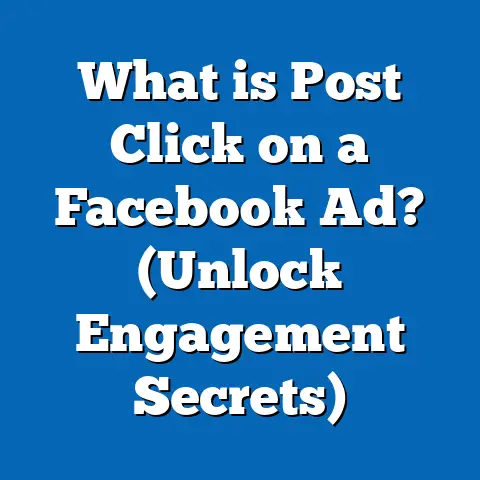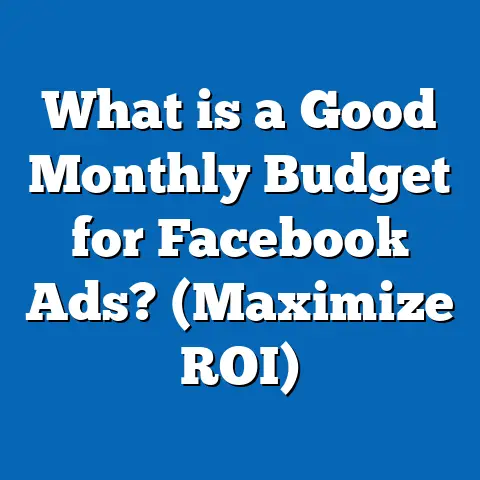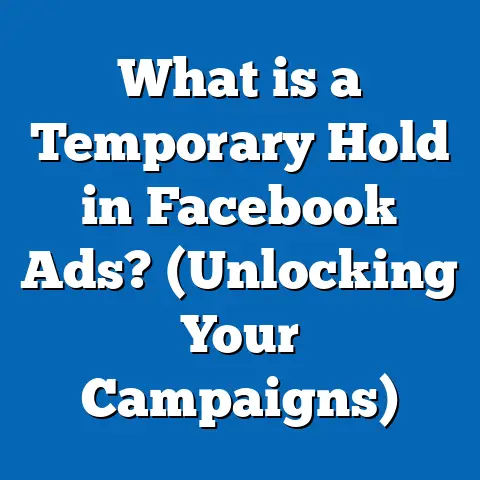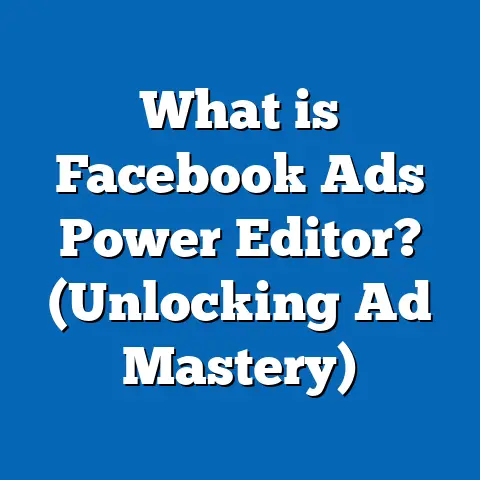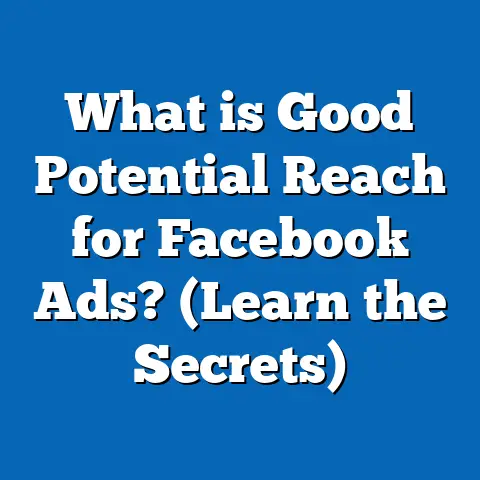What is the Ideal Size for Facebook Ads? (Boost Your Reach)
What is the Ideal Size for Facebook Ads? (Boost Your Reach)
Introduction
The size of your Facebook ad can make or break your campaign. In today’s ultra-competitive digital landscape, where billions of advertisers compete for user attention, optimizing your Facebook ads to the ideal size is crucial. An ad that fits perfectly into Facebook’s design framework not only looks professional but also drives better engagement, higher click-through rates, and ultimately more conversions.
Facebook, with over 2.9 billion monthly active users globally as of early 2024, offers unparalleled reach and targeting options. Yet, many marketers overlook one of the simplest yet most effective factors influencing campaign success: ad size. This guide explores everything you need to know about Facebook ad sizes—why it matters, what the ideal sizes are for each ad type and placement, how to optimize for performance, and how to stay ahead with the latest industry trends.
Why Ad Size Matters on Facebook
Before diving into numbers and formats, it’s important to understand why ad size matters so much for Facebook advertising.
1. User Experience and Engagement
Facebook’s algorithm prioritizes ads that provide a smooth, visually appealing user experience. Ads that don’t fit well or appear pixelated disrupt user experience and get penalized by the algorithm. For instance, ads that are improperly sized may be cropped automatically by Facebook, cutting off important parts of your message or visuals.
- Visual clarity: Ads with correct sizing appear crisp and professional.
- Layout harmony: Properly sized ads blend naturally into Facebook’s interface.
- User trust: Clear images and videos foster trust and higher engagement.
2. Algorithmic Advantage
Facebook’s ad delivery system evaluates ad relevance based on user interaction signals like clicks, likes, comments, and shares. Ads that look good and load quickly tend to get higher relevance scores, which in turn lowers your cost per result.
3. Cross-Device Compatibility
More than 94% of Facebook users access the platform via mobile devices (Statista 2024). Mobile screens come in various shapes and sizes. A properly sized ad ensures your content looks perfect on both desktop and mobile without distortion or cropping.
Data Insight
A 2023 study by Social Media Examiner found that ads optimized with Facebook’s recommended sizes experienced up to 30% more engagement and a 20% decrease in cost per click (CPC) compared to improperly sized ads.
Facebook Ad Formats: Overview and Ideal Sizes
Facebook offers multiple ad formats tailored for different marketing objectives and placements. Each format has its own ideal size specifications.
1. Image Ads
Image ads are straightforward yet powerful visuals displayed across various placements such as News Feed, Stories, Marketplace, and Right Column.
Ideal Image Sizes by Placement
| Placement | Recommended Size (pixels) | Aspect Ratio | Max File Size | Notes |
|---|---|---|---|---|
| News Feed | 1200 x 628 | 1.91:1 | 30 MB | Best for desktop & mobile |
| Stories | 1080 x 1920 | 9:16 | 30 MB | Full screen vertical |
| Marketplace | 1200 x 1200 | 1:1 | 30 MB | Square image |
| Right Column | 1200 x 1200 | 1:1 | 30 MB | Smaller sidebar placement |
Why These Sizes?
- News Feed (1.91:1) offers a landscape orientation ideal for desktop and mobile.
- Stories (9:16) leverage full vertical space on mobile devices.
- Square images (1:1) work well across placements offering versatility.
Best Practices for Image Ads
- Use high-resolution images (minimum 1080 pixels wide).
- Avoid text-heavy images; keep text under 20% of the image for better reach.
- Use vibrant colors and clear focal points.
2. Video Ads
Video content dominates social media engagement due to its multimedia appeal. Facebook supports multiple video ad formats, each with specific sizing.
Video Ad Sizes & Specifications
| Placement | Resolution | Aspect Ratio | Max File Size | Max Length |
|---|---|---|---|---|
| News Feed | Minimum 1080 x 1080 | 1:1 or 4:5 | 4 GB | Up to 240 minutes |
| Stories | 1080 x 1920 | 9:16 | 4 GB | Up to 15 seconds ideal |
| In-Stream | At least 1280 x 720 | 16:9 | 4 GB | Up to 15 seconds |
Why Different Aspect Ratios?
- Square (1:1) videos perform well in News Feed on both mobile and desktop.
- Vertical (9:16) videos are immersive in Stories and full-screen mobile placements.
- Horizontal (16:9) videos fit traditional video players like in-stream ads.
Video Quality Tips
- Use HD videos at minimum 1080p resolution.
- Keep videos short and engaging; Facebook recommends between 6-15 seconds for optimal engagement.
- Add captions since many users watch without sound.
Data Insight
Facebook reports vertical video ads have a 15-20% higher completion rate in Stories than horizontal videos.
3. Carousel Ads
Carousel ads allow advertisers to showcase multiple images or videos in a swipeable format within one ad unit.
Carousel Image/Video Specs
- Image size: 1080 x 1080 pixels
- Aspect ratio: 1:1 (square)
- Max file size: 30 MB for images; up to 4 GB for videos
- Number of cards: Between 2 to 10 per carousel ad
When to Use Carousel Ads?
- Showcase multiple products.
- Tell a visual story with sequential images/videos.
- Highlight features or benefits across different cards.
4. Collection Ads
Collection ads combine a cover image or video with product catalogs displayed in a grid below.
- Cover photo/video: 1200 x 628 pixels (aspect ratio: 1.91:1)
- Product images: Minimum 600 x 600 pixels (aspect ratio: 1:1)
These are especially effective for e-commerce businesses wanting to integrate product browsing directly in the ad.
How Incorrect Ad Sizes Affect Your Campaign
Using non-standard or incorrect sizes has several negative impacts:
Cropping Key Content
Facebook may automatically crop images or videos that don’t fit approved dimensions, cutting off critical text or visuals.
Poor Resolution & Blurriness
Low-resolution images scaled up by Facebook become pixelated, reducing professionalism and user trust.
Increased Costs & Reduced Reach
Facebook’s algorithm penalizes low-quality ads with higher costs per result because of lower relevance scores.
User Experience Issues
Ads that don’t display correctly frustrate users, leading to lower engagement rates.
Case Study: Global Retailer Boosts ROI by Optimizing Ad Sizes
A global fashion retailer ran two campaigns side-by-side:
- Campaign A used Facebook recommended sizes (1200×628 px for image ads).
- Campaign B used various non-recommended sizes without optimization.
Results after one month:
| Metric | Campaign A (Optimized) | Campaign B (Non-Optimized) |
|---|---|---|
| Engagement Rate | +45% | Baseline |
| Cost Per Click | $0.55 | $0.73 |
| Conversion Rate | +18% | Baseline |
Conclusion: Proper sizing led to clearer visuals, better user experience, and improved ROI.
Comparing Facebook Ad Sizes with Other Platforms
Understanding how Facebook’s ad sizes compare to other major platforms helps marketers create consistent cross-channel campaigns.
Owned by Meta, Instagram shares many size standards:
- Stories & Reels use vertical format (1080 x1920 px).
- Feed posts favor square (1080 x1080 px) but allow portrait (4:5) too.
Instagram’s visual-first platform favors vertical and square formats similar to Facebook but with more emphasis on full-screen vertical video content in Reels.
LinkedIn favors professional content with:
- Sponsored content images at 1200 x627 px (similar to Facebook’s landscape format).
- Video ads primarily horizontal (16:9) format.
LinkedIn ads often have less flexibility in aspect ratios but require high clarity for B2B audiences.
Google Display Network
Google requires multiple banner sizes depending on website placements:
- Common sizes include 300×250, 728×90, 160×600, which do not translate directly to Facebook’s social format.
Facebook ads lean towards more flexible formats optimized for mobile-first social feeds versus Google’s web banner ads.
Advanced Tips for Optimizing Facebook Ad Sizes
Beyond simply using recommended sizes, advanced strategies can improve performance further:
Always Start with High Resolution Files
Facebook compresses images/videos upon upload. Uploading high-res files reduces quality loss during compression.
Design Mobile First
Since over 94% of Facebook users are mobile, prioritize vertical (9:16) or square (1:1) formats that fill mobile screens without forcing horizontal scroll or awkward cropping.
Run A/B Tests of Different Sizes Within Campaigns
Split test various sizes even within same format:
- Compare square vs landscape in News Feed.
- Test vertical vs horizontal in Stories.
Use Facebook’s split testing tools to measure which size yields best engagement or conversions with your target audience.
Use Facebook Creative Hub Preview Tool
Creative Hub allows you to preview your ads exactly as they will appear across placements — desktop, mobile feed, stories — before launch. This prevents errors from wrong sizing.
Latest Trends in Facebook Ad Sizes & Formats (2024)
Facebook advertising evolves constantly. Here are recent trends shaping ad size strategies:
Vertical Video is Dominating
Inspired by TikTok’s success, vertical video ad usage on Facebook has surged by over 40% YoY in early 2024.
Vertical formats like Stories and Reels capture full screen attention better than traditional horizontal videos.
Interactive Instant Experience Ads Require Larger Covers
Instant Experience ads provide immersive full-screen experiences with product galleries, videos, and forms. They require cover photos/videos at larger dimensions such as 1200 x628 px but reward advertisers with higher engagement rates averaging +20% lift compared to static ads.
AI-Powered Resizing & Dynamic Creative Optimization
Meta’s AI now automatically adjusts creatives’ size and layout dynamically based on placement and audience preferences. However, manual optimization still outperforms AI resizing by around 15% in engagement metrics when combined with human design expertise.
Practical Examples of Ideal Facebook Ad Sizes in Use
Example 1 – Local Restaurant Boosting Reservations
A local restaurant wanted to promote a new menu launch:
- Used square image ads (1080×1080 px) featuring vibrant dishes on News Feed.
- Complemented by vertical Stories videos (1080×1920 px) showing food preparation.
Result: Reach increased by 35%, reservations up by 20% within a month due to better visual appeal on mobile users’ devices.
Example 2 – E-commerce Brand Launching Flash Sale
An online fashion retailer used:
- Carousel ads with multiple product images at perfect square size (1080×1080 px).
- Collection ads with cover video at recommended size (1200×628 px).
Results: CTR improved by 28%, conversion rate increased by 18%, reducing overall ad spend wastage.
Step-by-Step Guide: How to Choose the Ideal Size for Your Facebook Ads
To simplify size selection across campaigns:
Step 1: Define Your Campaign Objective
Is it brand awareness? Traffic? Conversions? Different objectives might suit different placements and sizes best.
Step 2: Choose Ad Format Based on Objective & Content Type
Image ads for quick impact; video ads for storytelling; carousel for multiple products; collection for e-commerce browsing.
Step 3: Select Placement(s)
Feed? Stories? Marketplace? Right Column? Each placement has specific size requirements.
Step 4: Create Your Visuals Using Recommended Dimensions
Use the exact pixel dimensions recommended by Facebook per placement listed earlier.
Step 5: Test Variations Using A/B Split Testing Tools
Try different sizes/aspect ratios within same campaign to optimize results.
Step 6: Monitor Metrics Closely & Adjust Accordingly
Watch CTR, CPC, relevance score, and engagement metrics; adjust creative sizes as needed.
Frequently Asked Questions (FAQs)
Q1. Can I use any image size for Facebook ads?
No. Using recommended sizes ensures your ad displays correctly without cropping or distortion, improving performance.
Q2. What happens if my image has too much text?
Facebook limits text overlay on images; more than roughly 20% text can reduce reach due to lower relevance scores.
Q3. Should I create separate ads for desktop vs mobile?
Often yes. Mobile-first vertical or square ads perform better on phones while landscape images might work better on desktop feeds.
Q4. Are video ads better than image ads?
Video generally leads to higher engagement but requires more investment and creative effort. Both are effective depending on goals.
Summary & Key Takeaways for Boosting Your Reach with Ideal Facebook Ad Sizes
- Use Facebook’s recommended pixel dimensions for each ad format and placement.
- Prioritize mobile-friendly vertical (9:16) and square (1:1) formats given the mobile usage dominance.
- Upload high-resolution creative assets to avoid compression artifacts.
- Utilize Facebook Creative Hub for pre-launch previews.
- Conduct thorough A/B testing comparing different sizes/formats within campaigns.
- Stay updated on trends like vertical video dominance and interactive Instant Experiences.
- Monitor campaign metrics regularly and optimize size choices based on performance data.
- Consider cross-platform consistency but adapt sizes according to platform-specific best practices.
Optimizing your Facebook ad size is a straightforward yet powerful step that can significantly improve your campaign’s reach, engagement, and ROI in today’s competitive advertising ecosystem.
If you want me to provide templates for all recommended sizes or a checklist summarizing this guide for quick reference during campaign design, just let me know!

